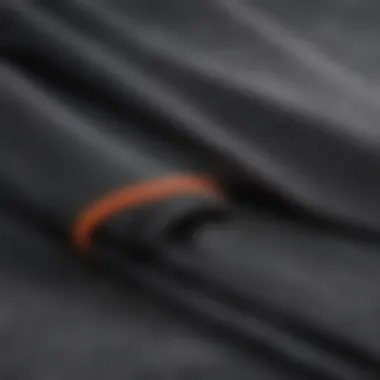Understanding Wetsuit Thickness for Kiteboarding


Intro
Choosing the right wetsuit thickness can feel like a maze for many water sports enthusiasts, especially for kiteboarders. The importance of this decision extends beyond mere comfort; it can significantly influence your overall performance on the water. When water temperatures fluctuate, so does the thermal protection needed to keep you safe and agile. This article aims to elucidate the relationship between wetsuit thickness and varying water conditions, focusing on what you need to know to optimize your experience.
Several factors come into play when selecting a wetsuit, and navigating the endless options available can be daunting. Temperature regulation is a key element. Each dive into the water translates to unique physiological reactions, particularly in cooler temperatures that can sap your energy and joy. By understanding how thickness corresponds to temperature, you not only maintain warmth but also sustain your performance and excitement in a sport that's all about being in the moment.
In this guide, we will provide comprehensive insights into the types of wetsuits available, how to read temperature charts, and the materials that are best suited to your needs. We'll also cover practical recommendations tailored specifically for kiteboarders, ensuring that whether you're an amateur or seasoned pro, you're well-prepared for each outing.
Gear Insights
Latest Gear Reviews
The evolution of wetsuits includes an impressive array of options, with manufacturers continually honing their technologies to bolster both warmth and flexibility. Recent reviews spotlight gains in neoprene quality, allowing for thinner wetsuits that don’t sacrifice insulation. Brands like O’Neill and Rip Curl have introduced their latest models with features that ensure you don’t feel like a turtle fighting against the tide.
For example, the O’Neill Psycho Tech has received rave reviews for its innovative Firewall lining which enhances heat retention while drastically reducing water entry points. These upgrades can afford kiteboarders the chance to take on cooler waters without feeling tethered by bulky gear.
Essential Gear for Beginners
If you’re just starting out in kiteboarding, picking the right wetsuit might feel overwhelming. Here are some essential guidelines:
- Thickness Matters: Beginner kiteboarders should consider a wetsuit around 3/2mm for temperate waters. This balance keeps you warm while offering enough flexibility to master the basics.
- Full vs. Short Sleeve: Depending on where you're located, a full wetsuit offers maximum coverage. However, in warmer climates, a shorty wetsuit can be more comfortable yet still provide some level of protection.
- Fit is Key: A good wetsuit should fit snugly without constricting movement. Look for a suit that molds to the body shape without excessive tightness.
Investing in quality gear right off the bat can help you progress faster and retain your enthusiasm, rather than being bogged down by discomfort.
Techniques and Tips
Advanced Tricks and Techniques
For those who have gained some confidence, understanding how your wetsuit interacts with your skill level during kiteboarding can elevate your game. As you experiment with more complex maneuvers, ensure your wetsuit remains a second skin rather than a burden. If you’re going for aerial tricks, thinner suits can provide the freedom of movement needed for those daring jumps.
Safety Practices for Kiteboarders
Safety cannot be stressed enough in water sports, and your wetsuit plays a crucial role in this. Here are a few practices to keep in mind:
- Check the Weather: Always have a quick look at temperature forecasts before hitting the water.
- Layer Up: If you're venturing into chillier waters, think about adding a vest or rash guard underneath your wetsuit for that extra layer of warmth.
- Stay Hydrated: Never forget to hydrate before getting into the water. Dehydration can exacerbate the effects of cold water exposure.
Remember, finding the right wetsuit thickness not only boosts your performance but also fortifies your overall safety during fun-filled kiteboarding sessions.
By making informed choices, you lay a solid foundation for both performance and safety in your kiteboarding adventures. With these considerations in mind, you're now on your way to mastering the waves with confidence.
Prologue to Wetsuit Thickness and Water Temperature
When embarking on an aquatic adventure, one must consider the impact of their gear, particularly the wetsuit, that acts as a second skin. The thickness of wetsuits becomes paramount in regulating body temperature, as water can steal heat away faster than a thief in the night. Understanding the relationship between wetsuit thickness and water temperature is not just a matter of comfort; it’s about safety and performance.
Choosing the right wetsuit thickness can tremendously enhance an experience, especially for kiteboarders who dance with the elements. Water temperatures fluctuate based on seasons, geographic locations, and even the time of day. This constant change necessitates a deep understanding of how different thicknesses react to these temperature dips and rises.
The Role of Wetsuits in Water Sports
Wetsuits serve as a vital piece of equipment in various water sports, acting almost like armor against the cold. They create a thermal barrier by trapping a thin layer of water against the skin, which warms up by body heat. But it's a balancing act; too thick a suit can lead to overheating, while too thin might leave you shivering in the gusting winds. It's not simply a snug fit that counts, but also the right thickness for the anticipated water temperature.
- Enhanced Insulation: Wetsuits maintain body warmth, significantly affecting endurance and performance.
- Flexibility Matters: A good wetsuit also allows movement. You want to feel like a dolphin, not a block of ice!
Importance of Understanding Water Temperature
Grasping water temperature specifics isn’t just a trivial pursuit; it’s fundamental for anyone engaging in water sports, especially kiteboarding enthusiasts. Water can feel deceptively warm or cold. What might seem like a pleasant day could turn into an icy plunge.
When we talk about water temperature, we can't overlook its role in affecting how our bodies react physically.
- Thermal Shock Risk: Entering water that’s much colder than body temperature can lead to unexpected shock, which is dangerous in any scenario.
- Performance Optimization: A suited athlete able to maintain body temp can function better and endure longer on the board.
Understanding these dynamics equips kiteboarders and others with the ability to make informed choices that directly impact their time on the water. Recognizing where temperature affects performance may lead to better grip on board and sharper turns.
Ultimately, being armed with knowledge about wetsuit thickness in relation to water temperature can be a game-changer for water adventurers. It’s about turning the unpredictable nature of water into a reliable playground.


Principles of Thermal Regulation in Water
Understanding how thermal regulation works in water is crucial for anyone engaged in water sports, particularly kiteboarding. Water has a much higher thermal conductivity than air, meaning that heat loss happens at an alarming rate. As water temperature varies, so does the body's need for proper thermal insulation, which is often provided by wetsuits. This section aims to explore the principles of thermal regulation, breaking down the mechanism of heat loss and the impact that water temperature can have on maintaining body heat.
Heat Loss in Water
In the water, the body loses heat at various rates influenced by several factors. One critical piece is the ambient water temperature. As a general rule, the cooler the water is, the faster heat escapes from the body. When immersed in water, human bodies experience heat loss that can be several times quicker than in air, resulting in chilling effects even in mild temperatures.
"Many a brave adventurer has miscalculated their insulation needs and found themselves shivering, even on sunny days!"
Here are some specific factors that contribute to heat loss in water:
- Conductivity: Water conducts heat away about 25 times faster than air. This elevates the risks of hypothermia, especially in colder temperatures.
- Current and Movement: Water movement, whether through currents or waves, can enhance heat loss. A calm sea might feel warmer compared to a windy day where the water is disturbed.
- Duration of Exposure: Longer exposure increases heat loss. Many kiteboarders might not think about how prolonged periods in colder water can lead to significant temperature drops in the body.
- Body Composition: Individuals with less body fat may experience heat loss more quickly because fat acts as a natural insulator.
These elements call for kiteboarders and hobbyists to remain vigilant about their wetsuit thickness based on their expected duration in water.
Impact of Water Temperature on Body Heat
Water temperature can dramatically affect how the body regulates its heat. As the temperature gauge dips below certain thresholds, the body's thermoregulation processes become more urgent, and this is where a well-chosen wetsuit can come into play.
The relation between water temperature and body heat can be described in several stages:
- Warm Water (>24°C / 75°F): In such temperatures, individuals report feeling comfy in a thin wetsuit or even just a rash guard while engaging in activities. The body's own thermal regulation is sufficient to handle minor chills from breezes or splashes.
- Mild Water (18°C - 24°C / 64°F - 75°F): A thicker wetsuit, such as a 3/2 mm suit, becomes necessary here. It provides a barrier to slow down heat loss without suffocating the body’s natural ability to cool down. Propositioning heat retention allows for better enjoyment of kiteboarding.
- Cold Water (10°C - 18°C / 50°F - 64°F): This is where a more serious approach is required. A wetsuit thickness like 4/3 mm or even a dry suit is essential. At these temperature levels, the body can lose heat quickly and may not regulate temperature efficiently, leading, in turn, to serious risks like hypothermia.
With these considerations in mind, it's clear that understanding thermal regulation is not merely an academic pursuit but a lifeline for water sports enthusiasts. Proper outfitting can make the difference between a thrilling adventure and a life-threatening ordeal. It reinforces the need for kiteboarders to be well-acquainted with their environment and the nuances of their gear.
Evaluating Wetsuit Thickness Options
When you’re out on the water, it’s hard to overstate how crucial it is to have the right wetsuit thickness. Not only does it provide the insulation needed to keep your core warm, but it also plays a significant role in your overall comfort and performance during activities like kiteboarding. Evaluating wetsuit thickness options can mean the difference between a fantastic day riding the waves and one spent shivering, which no one wants.
Understanding the right thickness helps in aligning your gear with the specific conditions you’ll be facing. Each wetsuit model comes in various thicknesses, and having a good grasp of what those numbers mean can ensure you don’t end up under-dressed for chilly waters or over-baked in the heat. Depending on your activity level, the variations in water temperature, and personal comfort preferences, selecting the proper wetsuit thickness is essential for maximizing performance.
Common Wetsuit Thicknesses
Wetsuits come in a range of thicknesses, each designed for unique environmental conditions. Let’s break down the most common options:
- Shorty Wetsuits (1-2mm): Ideal for warmer conditions. They keep core heat retained but allow for excellent flexibility.
- 3/2mm Full Suits: These are quite popular for moderate temperatures, balancing warmth with the needed mobility for kiteboarding.
- 4/3mm Wetsuits:
As you veer into colder waters, this thickness starts to become necessary, offering added insulation for comfort while still supporting flexibility. - 5/4mm Wetsuits:
Often used for colder climates, these suits provide warmth for those longer sessions when you’re out in frigid waters. - Dry Suits:
These are a completely different beast as they don’t let any water in—perfect for seriously cold conditions, but can be bulky.
Each of these thicknesses serves a purpose, and understanding the benefits of each can guide you significantly in selecting your next wetsuit.
Selecting Thickness Based on Temperature Ranges
Choosing the right wetsuit thickness is much less about personal choice and more about the water you are going to get into. Here’s how to approach this:
- Warm Water (65°F and above):
A shorty wetsuit or even a rash guard could suffice, allowing for plenty of movement while maintaining some comfort as the sun beats down. - Moderate Water (60°F to 65°F):
A 3/2mm full suit is typically recommended; it balances flexibility and warmth effectively, keeping your body heat where it counts while allowing for a decent range of motion. - Cold Water (under 60°F):
As the numbers drop, so should your wetsuit thickness. The 4/3mm to 5/4mm wetsuits are ideal, providing the necessary insulation to stave off that bone-chilling cold.
"The thickness of your wetsuit can directly affect how long you're able to enjoy the water without feeling the bite of cold or the heat of the sun. For kiteboarders, maximizing comfort through appropriate thickness is tantamount to a pleasurable experience."
Choosing the correct wetsuit thickness is not to be overlooked. Make these evaluations based on your conditions, and you’ll surely enhance not just your performance but your enjoyment on the water.
Specific Temperature Thresholds and Corresponding Wetsuit Recommendations
Choosing the right wetsuit thickness is paramount when it comes to water activities like kiteboarding, where temperature can make or break not just comfort but performance as well. Each temperature range has its own nuances, and understanding them can help enthusiasts make informed choices. The recommendations outlined here are based not just on comfort, but also on safety; after all, staying warm and protected is key to a successful outing on the water.
Warm Water Conditions
Shorty Wetsuits
Shorty wetsuits are a popular option for warm water conditions, typically in temperatures ranging from 70 to 85 degrees Fahrenheit. They cover the torso, but the arms and legs are usually exposed, which keeps the user from overheating while still benefiting from some thermal protection. The main draw of shorty wetsuits is their versatility; they allow for freedom of movement and are easy to don and doff. They tend to be made from thinner neoprene material, often around 2mm to 3mm.
One key characteristic of shortys is their fantastic drainage capabilities. These suits often have an angled zipper or no zipper at all, allowing water to flow in and out easily. The trade-off, however, is reduced insulation compared to full wetsuits. In environments where the sun is out and temperatures are high, a shorty can minimize the risk of overheating while still guarding against minor scrapes and stings from aquatic life.
Rash Guards


On the other end of the spectrum, we have rash guards. These snug-fitting tops are composed of thin, stretchy fabric designed to provide UV protection and a bit of insulation. Rash guards excel in warm conditions, especially when one is more focused on minimizing sun exposure and rashes from board chafing. Typically worn in the warmer end of the same temperature range as shorties, they are lightweight and great for layering under wetsuits.
The unique feature of a rash guard is its breathability. While it doesn’t offer the same level of thermal protection as a wetsuit, it helps regulate body temperature effectively. They are particularly useful in tropical waters where the risk of overheating is high, making them a staple for many kiteboarders albeit with the consideration that they do not provide much buoyancy or warmth in cooler conditions.
Moderate Water Conditions
/2mm Full Suits
When water temperatures dip but are still moderate, often falling between 60 to 70 degrees Fahrenheit, a 3/2mm full wetsuit can be the ticket. These suits provide more coverage and retain more heat compared to their shorts counterparts, ideal for cooler days on the water where extended sessions are likely.
The 3/2mm designation means that the suit is 3mm thick in the core and 2mm thick in the limbs, allowing for a balance between warmth and mobility. The key advantage lies in its full-body coverage which drastically reduces water loss, enhancing overall thermal insulation. This makes it a preferred option for those who frequent transitional weather or cooler waters.
2mm Springsuits
2mm springsuits serve as another excellent option for those navigating moderate conditions. These suits typically cover the torso and either short sleeves or long sleeves, but the legs may be short or even just cover the upper thigh. The versatility allows for a snug fit while providing just enough insulation.
Springsuits often feature light neoprene, making them a favorite during spring and fall seasons. Their unique design provides ample protection against wind and splash, while still keeping the wearer agile. However, they may not be suitable for extended exposure in water that is on the colder end of the spectrum due to reduced thermal retention.
Cold Water Environments
/3mm and /4mm Wetsuits
In cold water settings, keeping warm is crucial. Wetsuits with thicknesses of 4/3mm or even 5/4mm are designed to trap heat efficiently in temperatures below 60 degrees Fahrenheit. The thicker neoprene insulates effectively and has features to minimize flushing—water entering the suit—which is key when dealing with frigid conditions.
One of the noteworthy characteristics of these suits is their sealed seams, often glued and blind-stitched, which add to the overall insulation. A common drawback, however, is the bulkiness. While they keep you warm, the increased thickness can restrict movement slightly.
Dry Suits
For the coldest environments, dry suits come into play. These unique suits are designed to keep you completely dry while providing layer options underneath for thermal regulation. They’re especially popular in colder regions and can often handle temperatures that would otherwise be unbearable in a traditional wetsuit.
The standout feature of dry suits is their waterproof shell, allowing the wearer to manage their insulation through the added layers, making them adaptable to a wide range of conditions. However, they require a bit more care and finesse in terms of fitting and sealing to maintain effectiveness—a consideration that might deter some casual kiteboarders.
Key Takeaway: Understanding the specific temperature ranges and the corresponding wetsuit recommendations is crucial. It not only enhances the kiteboarding experience but also significantly contributes to personal safety and comfort on the water.
Materials and Construction of Wetsuits
Wetsuits are more than just a second skin; they are carefully woven systems designed to fend off the chill of the ocean while providing flexibility and comfort. Understanding the materials and construction of wetsuits is crucial for kiteboarders and other water enthusiasts, as these factors directly influence your performance and safety in the water. The right materials not only help to retain body heat but also offer protection against the elements. Let's explore what makes a wetsuit tick.
Neoprene Variations
Neoprene, a synthetic rubber, is the backbone of most wetsuits, but not all neoprene is created equal. Different variations exist, each tailored to specific needs.
- Standard Neoprene: This is the traditional style, providing decent insulation and good flexibility. It's a fair choice for moderate conditions.
- Ultra-thin Neoprene: Perfect for warmer water, this type minimizes bulk while maximizing freedom of movement. Ideal for short sessions in the sun.
- Limestone Neoprene: A more eco-friendly option, made from limestone instead of oil, this variation is lighter and generally warmer than its traditional counterpart. It’s vital for those who want to minimize their environmental impact without sacrificing performance.
- Super-stretch Neoprene: Designed for flexibility, this type offers excellent movement, making it popular among high-performance kiteboarders. Its ability to stretch can help you catch the waves without feeling restricted.
Choosing the right neoprene is not just about warmth but also about how it allows freedom of movement during maneuvers.
Seam Construction and Water Resistance
One aspect often taken for granted is how seams are constructed in wetsuits. The method used can have a significant effect on water resistance, comfort, and durability.
- Flatlock Seams: These seams are easy on the skin but not the worst at keeping water out. They are mainly found in warmer suits designed to be more comfortable than leak-proof.
- Blind Stitch Seams: This is a step up; the needle doesn’t go all the way through. They provide a better seal against water while maintaining flexibility but need occasional repairs from wear and tear.
- Taped Seams: For the coldest of waters, these seams are reinforced with tape, greatly enhancing water resistance. They often end up being the choice for 4/3mm and thicker wetsuits.
"The best wetsuit is not just warm, it’s one that fits your needs like a glove."
The construction of seams inevitably influences how a wetsuit performs in various conditions. In colder waters, choosing a suit with taped seams can keep you warm longer, allowing you to focus on your riding rather than shivering in the ocean. Kiteboarders often find that a balance between various seam types and neoprene variations can lead to the best overall performance.
Epilogue
In summary, understanding the materials and construction methods used in wetsuits can significantly impact your water sports experience. Whether it’s the flexibility offered by super-stretch neoprene or the watertight properties of taped seams, knowing what options are available can help you make informed choices tailored to your needs. Always remember, comfort leads to confidence, and confidence leads to enjoyment.
Wetsuit Fit and Comfort Considerations
When it comes to enjoying water sports like kiteboarding, the fit and comfort of a wetsuit are as crucial as its thickness. A well-fitted wetsuit not only enhances performance but also plays a vital role in regulating body temperature against various water conditions. It helps in preventing excessive heat loss while allowing for freedom of movement, which is key for any water adventurer.


Importance of Proper Fit
A proper fitting wetsuit hugs the body snugly, offering insulation without restricting movement. When the wetsuit fits correctly, it minimizes water entry while maximizing comfort. Here are several key reasons why this is important:
- Thermal Efficiency: A wetsuit should fit like a second skin to trap a thin layer of water. This layer warms up quickly and helps maintain body temperature.
- Mobility: Kiteboarding requires a wide range of motion. A too-tight or too-loose suit can hinder movement, making it difficult to catch wind or steer.
- Prevention of Chafing: Ill-fitting wetsuits are notorious for causing chafing or irritation, especially during extended periods on the water. A well-designed suit reduces these risks significantly.
- Increased Confidence: When feeling comfortable in your gear, one can focus on the thrill of riding the waves instead of adjusting or dealing with discomfort.
Thus, it’s essential to try various brands and cuts to find a wetsuit that complements your body shape and activity level.
Adjustments and Modifications
After selecting a wetsuit, there might still be a need for fine-tuning to perfect the fit. Here are a few adjustments and modifications that can greatly enhance comfort:
- Taping of Seams: If seams rub against the skin, specially designed taping can provide additional protection.
- Lycra Rash Guards: Wearing a rash guard underneath can minimize chafing while also adding additional insulation.
- Ankle and Wrist Seals: Ensuring tight ankle and wrist seals prevents water seepage, which can be particularly useful in colder temps.
- Custom Tailoring: For those who find it exceedingly tough to fit into standard sizes, seeking out professional alteration can be a game-changer.
"A well-fitted wetsuit is not just about comfort; it can mean the difference between an exhilarating day on the water and a frustrating experience."
Ultimately, taking time to ensure a snug, comfortable fit — through trial, adjustments, or even custom alterations — can significantly impact your water sports experience.
Effects of Environmental Variables on Wetsuit Performance
Understanding the impact of environmental factors on wetsuit performance is crucial for kiteboarders and water enthusiasts alike. The way wind and water interact with a wetsuit can make a world of difference in comfort and safety, not to mention overall performance in various water conditions. If you're out there for hours, even small changes can lead to big differences in your experience. Knowing how these conditions play into your gear choice helps you make informed decisions.
Wind and Water Movement
When you're kiteboarding, both wind and water movement are your constant companions. Strong winds can cause the water surface to become choppy, influencing how your wetsuit performs. A good wetsuit should provide an adequate seal at the cuffs and neck to prevent water from seeping in when you dive or wipe out.
- Adverse Effects: High winds increase the chances of wind chill, causing your body to lose heat faster while you're in the water. This means the insulation offered by your wetsuit is more critical than it seems. If the wind's howling and you're in a thinner wetsuit, you might feel the cold biting right through. Choosing a wetsuit with a thicker insulation layer can help buffer against this chilling effect, especially in gusty conditions.
- Water Movement: The ripples and waves of the ocean or lake can also affect your body heat. When you're paddling or getting tossed around by the surf, water can continuously wash over your body, carrying away warmth and raising the demand on your wetsuit's thermal capabilities. A snug fit helps mitigate this, as it prevents unnecessary water movement between your body and the wetsuit.
In short, consider the environmental conditions you’ll be facing. The less heat loss, the better your overall kiteboarding experience.
Sun Exposure and UV Protection
Many kiteboarders often overlook the harmful effects of the sun while out on the water. UV exposure is a sneaky adversary that can take a toll, especially during long sessions. While wetsuits are primarily designed for insulation, certain types also provide UV protection, which can be a lifesaver.
- Burn and Skin Health: Prolonged exposure to the sun can lead to sunburn, which not only causes pain but can also result in serious skin conditions over time. Look for wetsuits with UV protection ratings to keep your skin safe while you chase thrills on the water.
- Comfort Considerations: A wetsuit that offers UV protection is typically made from materials that reflect sunlight. This means that on hot, sunny days, you might feel less like you’re roasting under the sun's rays. Many brands now incorporate this feature, ensuring that those spending long hours in the water remain comfortable and protected.
The End and Final Recommendations
In wrapping up our exploration of wetsuit thickness relative to water temperature, it's essential to recognize how crucial it is for any water enthusiast—especially kiteboarders—to understand this interplay. Selecting the appropriate wetsuit thickness is not merely a matter of comfort; it directly impacts your performance on the water and your overall safety. As water temperatures fluctuate, the effectiveness of thermal regulation becomes paramount, and a well-suited wetsuit can mean the difference between an enjoyable day out and a chilly, uncomfortable experience.
Choosing the right wetsuit is about more than just numbers. It involves considering the specific environmental conditions you are likely to encounter, your personal tolerance to cold, as well as the intensity of your activities. A thick wetsuit may be a wise choice if you’re planning to spend prolonged periods in colder waters. Conversely, a thinner wetsuit can provide you with better mobility in warmer temperatures, allowing for an enhanced performance when it comes to movements and agility on the board.
Also, don’t forget about local weather variables like wind and sun exposure. Wind chill can make temperatures feel significantly colder, while UV rays can pose risks to your skin, underscoring the need for protection through your wetsuit choice.
Key Elements to Consider:
- Water temperature: Always check local conditions before heading out.
- Activity type: Strenuous activities can raise body temperature, influencing wetsuit thickness choice.
- Personal comfort: Everyone has a different tolerance for cold, so be honest about yours.
Ultimately, remember that your wetsuit is an investment in your safety and enjoyment. Whether you are just starting or are an experienced kiteboarder, understanding the nuances of wetsuit thickness can enhance both your skills and your time spent on the water.
Summarizing Key Points
To distill our discussions, here are pivotal points that were addressed:
- Thermal regulation: Understanding how body heat is maintained in water informs wetsuit choice.
- Thickness selection: Choosing the right wetsuit thickness according to specific temperature ranges is critical for comfort.
- Environmental variables: Mind the effects of external conditions, including wind and sun exposure on performance and comfort.
- Individual preferences: Personal comfort should guide choices, as it varies from person to person.
With this in mind, you’ll set yourself up for more enjoyable outings. Be cautious and mindful about every aspect from your gear to the environment around you.
Encouragement for Personal Exploration
As you step out into the world of water sports, remember that personal exploration is where true learning happens. Don't be afraid to try different wetsuit options to find what suits you best; experimentation is key to discovering your own limits and preferences. Whether you’re in tropical waters or braving chilly currents, each experience will provide invaluable insight.
Consider documenting your experiences. Note down what worked and what didn't in terms of thickness and construction materials. Connecting with fellow kiteboarders on platforms like Reddit or Facebook can open up a wealth of shared knowledge, as everyone has their own stories and tips to offer.
In the end, the journey of understanding wetsuits is ongoing. Keep track of innovations in materials and designs, as the industry is consistently evolving. Ask questions, seek recommendations, and adapt your choices based on firsthand experience. Gains in both knowledge and comfort will be the fruits of your personal exploration.
"The sea, once it casts its spell, holds one in its net of wonder forever." – Jacques Cousteau
So, gear up, dive in, and enjoy every exhilarating moment on the water!















